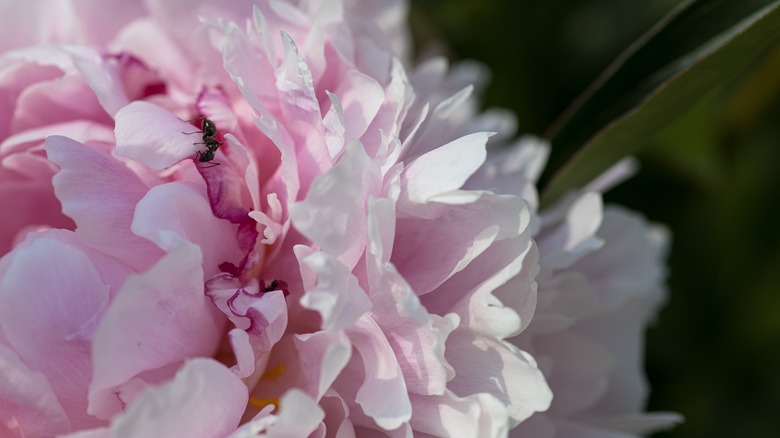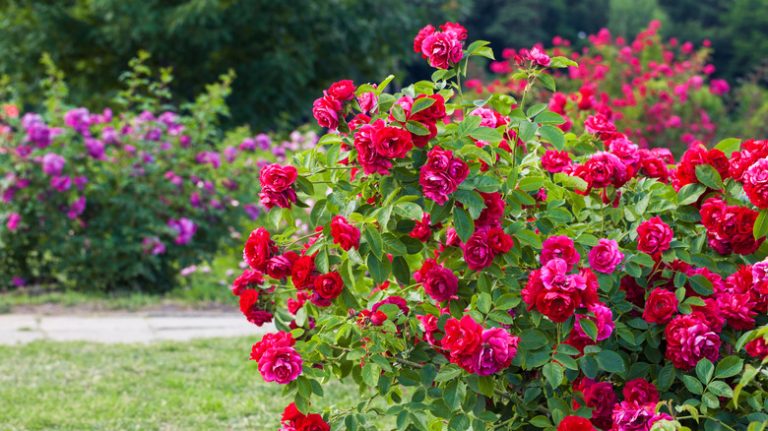Marco Polo’s evocation of peonies (Paeonia spp.) as cabbage-sized roses does them a grave injustice. Hued crimson reds, blush pinks, creamy whites, and blackish-purples — there are myriad forms of these exquisite, billowy flowers. There are Japanese, Anemone, and Bomb types, to name a few, and all can enthrall onlookers. This awe, however, soon gives way to annoyance when ants come into the picture, throwing your flower arrangement plans into jeopardy. Fortunately, there are several ways you can get rid of ants before bringing your peonies indoors. Start by shaking the cut blooms and watch the ants get thrown out. If that doesn’t solve the problem, wash out the crawlies by submerging the flower heads in water. Interestingly, cutting peonies at their “marshmallow” budding stage (when they are close to blooming) is another method to remove the pesky ants before they make home in the petals and become a full-blown, unsightly nuisance. Afterward, you can replant them indoors.
Don’t worry about the blooms either, as the myth that ants tickle their buds to spur their opening holds no truth — they’re merely snacking on the sweet nectar. Your flowers will blossom irrespective of their presence.
Ease off the ant(sy) problem

Unlike most flowering plants, peonies secrete their sticky sap on their sepals (as opposed to inside the flower) to entice pollinators. But they also end up attracting ants. While the hungry critters are primarily there to lick off the nectar, they’re equally aggressive in lapping up the honeydew produced by the common peony enemies: aphids and scale insects. So, considering the pivotal role they play in protecting the gorgeous blooms from harm, it’s no surprise that many garden gurus, including Martha Stewart, have found an unexpected way to deal with ants on peony flowers. (Hint: They leave them be.)
Mutual benefits aside, there’s no debating that you wouldn’t want these ants inside your home. The mere thought of them crawling down the flower vase after cleaning off all the full-bloom sweetness is repulsive. So, tackle the problem at its source by reducing the number of ants swarming your flowers. Plant herbs like lavender and mint (they find the aroma detestable) and spread diatomaceous earth or cinnamon on the soil to keep them away. But if you can’t be bothered with these cultural practices, just hose the blooms — it’ll clean out the nectar as well as the insects. Or try out the following methods.
Shrug off the ants
The DIY Mommy/YouTube
If you find the sight of ants off-putting, banish their presence by cutting the peonies when the insects are least active, and the flowers have blossomed fully. Early morning is usually the best time — when the foliage still holds traces of heavy dew and the insects are out of action. While cutting the blooms, ensure you’re grasping the stem right underneath the flower — otherwise, the weight of the head could rip it off. Afterward, turn your hand so the flower tops are facing the ground.
Proceed to lightly pat the stalks at the point not far off the petals (just avoid being overly aggressive). You can even slap multiple stems against each other to displace the pests. Afterward, flick off any ants still hanging on to the petals and add the peonies to your flower arrangement. If you aren’t interested in using them immediately, bring the cut stalks indoors, wrap them in moist paper towels, place them in a plastic container, and refrigerate them. Cut the stalks afresh and soak them in warm water for a bit to open the flowers before using them.
Bathe the cut peonies
If shaking off the cut stalks doesn’t get all the ants out, soak your peonies in water (this works as a standalone method as well). Bring out a bucket in your garden and fill it up with cold water. Make sure the water level is way under the brim, lest the nectar-sappers crawl out. Some people recommend adding two drops of dish soap to the container. With your blooms facing the bucket, dip them into the water and leave them for around 20 to 30 minutes until you see the critters swimming out. If necessary, swirl the peonies around to remove any lingering ants.
Lightly shake the cleaned blooms to drain out the excess water, and use them however you like. Remove the leaves, though, if you plan on putting them in a vase, or else they’ll make the water murky real quick. Don’t worry if the peonies turn floppy — they’ll become their old, majestic selves once dry. For an even simpler routine, wash the blooms under a sink faucet.
Cut the marshmallow buds
The DIY Mommy/YouTube
If the peonies are still budding and you’d rather avoid the ant plague, picking the buds early is an option. The downside, though, is that finding the right cutting time is tricky, and you may have to check the buds multiple times throughout the day to make sure you don’t miss the bus. The key lies in getting them when they turn soft, akin to a marshmallow, and the sepals have opened up slightly to reveal the light color. Squeeze the buds between your thumb and forefinger if you’re unsure about their condition. If you’re growing red cultivars, wait a while longer until the buds turn even softer.
When using them in a cut flower arrangement, strip the 15- to 18-inch-long stalks of all but three sets of leaves and remove them. Also, make sure the buds are around 1 to 1¾ inches wide before harvesting them. Follow up by washing the buds with water to remove the scout ants. Get them inside and wait for around 20 minutes before placing them in water — not doing so will force the plants to flower prematurely. Your peonies will bloom after eight to 48 hours of being plucked and put in water. If you wish to use them later, refrigerate them horizontally after packing them in a plastic container.


